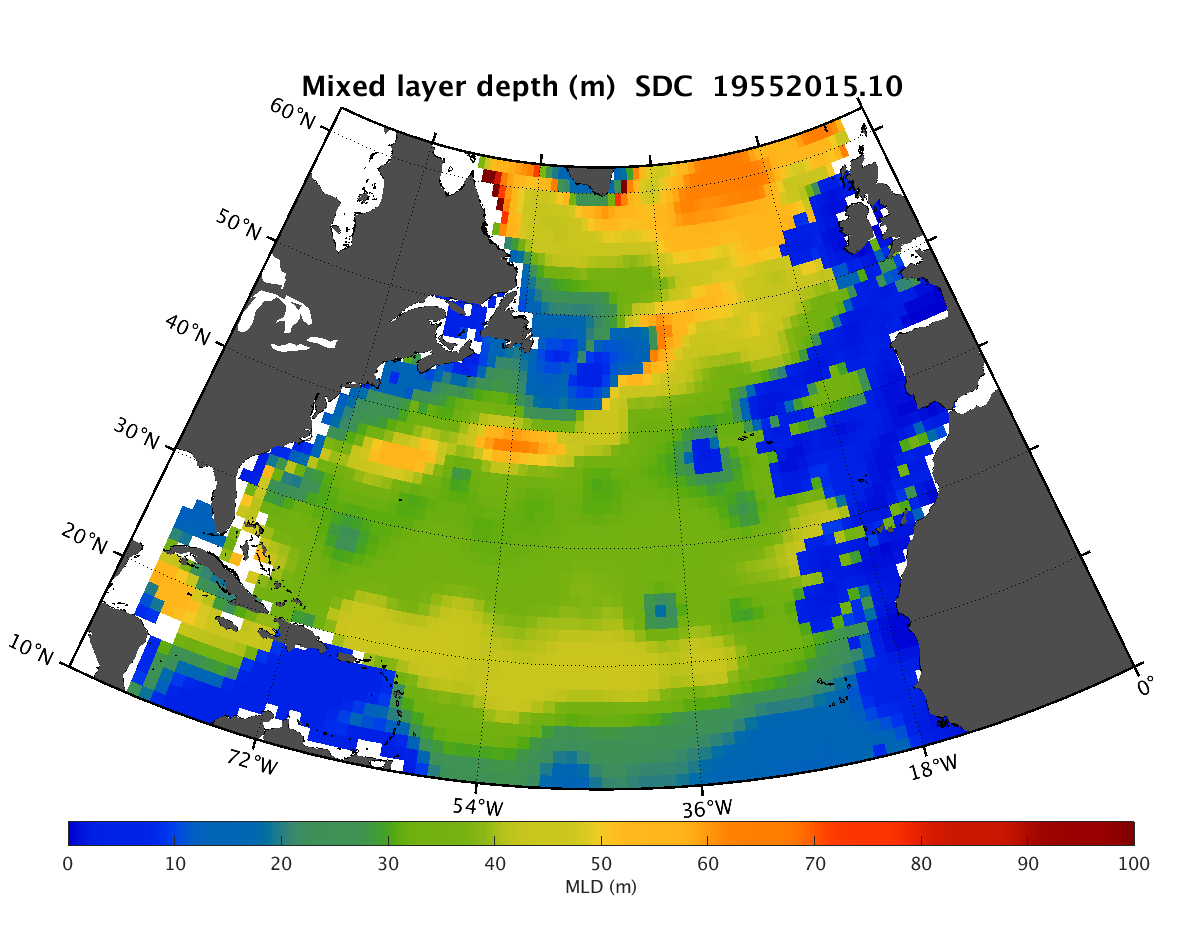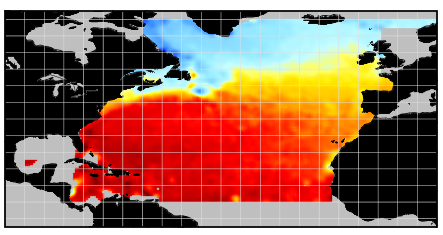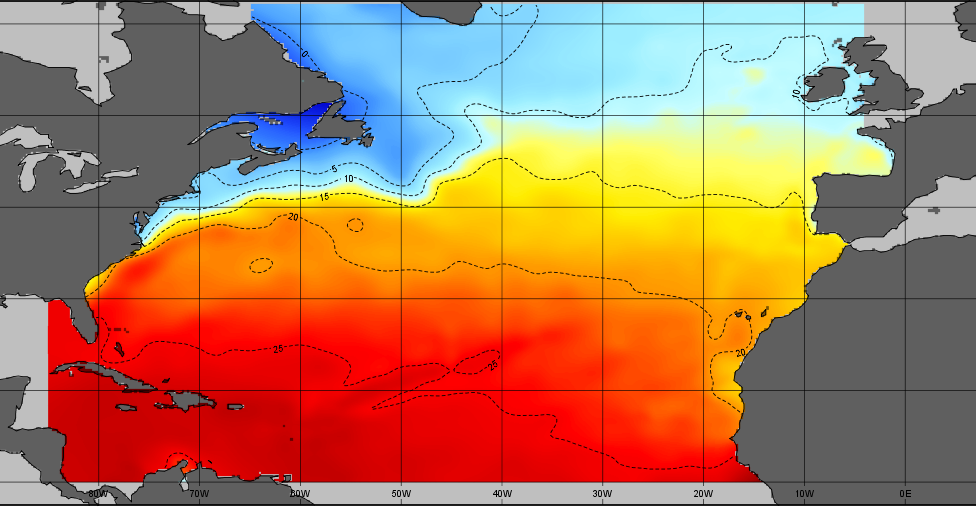North Atlantic Ocean
Type of resources
Available actions
Topics
INSPIRE themes
Keywords
Contact for the resource
Provided by
Years
Formats
Representation types
Update frequencies
Scale
Resolution
-

The SDC_NAT_DP1 product contains the North Atlantic Ocean monthly climatology for mixed layer depth (MLD) based on temperature climatology spanning 60 years (1955-2015). The MLD fields have spatial resolution 1/4°. The profiles of temperature combines data from 2 major sources, the SeaDataNet infrastructure and a part of data of the Coriolis Ocean Dataset for Reanalysis (CORA). The used climatology is the SeaDataCloud North Atlantic Ocean Temperature Climatology V1 (https://doi.org/10.13155/61810) done with the DIVA software, version 4.7.2. The product was developed in framework of the SeaDataCloud project. This product must be considered as feasibility study for the next phases, it is a beta-version and that further research needs to be done before its usage from users.
-

The SDC_NAT_CLIM_TS_V2 product contains Temperature and Salinity Climatologies for the North Atlantic Ocean including the seasonal and monthly fields for 7 decades starting from 1950 to 2019. One resolution has been processed : 1/2°. The climatic fields were computed from the integrated North Atlantic Ocean dataset that combines data extracted from the 2 major sources: SeaDataNet infrastructure and Coriolis Ocean Dataset for Reanalysis (CORA). The computation was done with the DIVAnd software.
-

The SDC_NAT_CLIM_TS_V1 product contains Temperature and Salinity Climatologies for the North Atlantic Ocean including the seasonal and monthly fields for period 1955-2015 and seasonal fields for 6 decades starting from 1955 to 2015. Two resolutions have been processed : 1/2° and 1/4°. The climatic fields were computed from the integrated North Atlantic Ocean dataset that combines data extracted from the 2 major sources: SeaDataNet infrastructure and Coriolis Ocean Dataset for Reanalysis (CORA). The computation was done with the DIVA software, version 4.7.2.
-
In many places, marine phosphorites are accompanied by Fe-Mn crust mineralisations on the seafloor of continental shelves and slopes along the western continental margins of the Atlantic Ocean. They tend to occur in waters of medium depth. Some thick Fe-Mn crusts also contain carbonate fluorapatite, which was incorporated into the crusts during specific periods prior to middle Miocene during main Cenozoic episodes of phosphatization. These deposits are related to strong upwelling along the continental margins and seamounts. Marine phosphorites are known to concentrate rare earth elements and yttrium (REY) during early diagenetic formation. Although there are several references to ferromanganese crusts and their association with phosphorites in the literature, the genetic models for explaining their relationship and metal concentration are still poorly understood.
-
"Exploration in the Atlantic, Mediterranean, Baltic and Black Sea" refers to marine exploration of mineral accumulations, deposits, resources and reserves on the Atlantic. Mediterranean, Baltic and Black Sea seabed. The target for MINDeSEA WP 7 is (i) to create a new dataset on the distribution of the explored areas for submarine mineral resources in Europe; (ii) to propose recommendations for new unexplored areas; and (iii) to recommend pilot areas with high potential of discovering new submarine mineral resource mineral accumulations
-
Marine ferromanganese crust deposits are potential mineral resources that contain base metals and strategic and critical elements such as cooper (Cu), cobalt (Co), vanadium (V), nickel (Ni), titanium (Ti), platinum group elements (PGEs) or rare earth elements (REEs). Traditionally, marine precipitates are defined as: a) purely hydrogenetic when all constituents are derived from cold seawater, (b) diagenetic, when all constituents are derived from cold sediment pore water; and (c) hydrothermal when precipitation occurs in the vicinity of hydrothermal vent sites from fluids with temperatures higher than ambient bottom waters. Hydrogenetic Fe-Mn crusts occur throughout the global ocean on seamounts, ridges and plateaus, where currents have kept the rocks free of sediment for millions of years. Some ferromanganese (Fe-Mn) crusts exhibit a mixed origin, primarily either hydrothermal-hydrogenetic or hydrogenetic-diagenetic (Hein et al., 2000; 2003; 2013; Muiños et al. 2013; Bau et al., 2014; Marino et al., 2017). In many places, marine phosphorites are accompanied by Fe-Mn crust mineralisations on the seafloor of continental shelves and slopes along the western continental margins of the Atlantic Ocean. Some thick Fe-Mn crusts also contain carbonate fluorapatite, which was incorporated into the crusts during specific periods prior to middle Miocene during main Cenozoic episodes of phosphatization. These deposits are related to strong upwelling along the continental margins and seamounts. Marine phosphorites are known to concentrate rare earth elements and yttrium (REY) during early diagenetic formation (Hein et al., 1993; 2016; González et al., 2016). Although there are several references to ferromanganese crusts and their association with phosphorites in the literature, the genetic models for explaining their relationship and metal concentration are still poorly understood.
-
Polymetallic nodules occur in abyssal plains (~4000 – 6000 mm water depth) of all major oceans as two-dimensional deposits, formed on or just below sediment-covered seafloor, rich in metals of economic interest such as manganese (Mn), nickel (Ni), copper (Cu), cobalt (Co), molybdenum (Mo), titanium (Ti), lithium (Li), and rare earth elements (REE). The nodules are generated in marine environments where the sedimentation rates are low, commonly less than 10 centimeters (cm) per thousand years. The nodules consist of micro-layers of Mn oxides and Fe oxy-hydroxides concentrically precipitated around a nucleus. Nodules are generally about golf ball sized, most commonly 1–12 cm in diameter, but can vary in diameter from millimeter-size (micronodules) to as large as 20 cm. The polymetallic nodules are formed by metals precipitation either from ambient seawater (hydrogenetic formation), from pore-waters in the sediments (diagenetic formation), from hydrothermal derived fluids (Bonatti and Nayudu, 1965; Bau et al., 2014; Kuhn et al., 2017) and the formation processes that represent a mix of these different end-member processes. The formation mechanisms control the general chemical composition of the nodules, e.g. the hydrogenetic precipitation leads to an enrichment of Co and REE while the diagenetic precipitation favours enrichment of Ni and Cu. Hydrogenetic nodules grow remarkably slow (1 to 5 mm per million years), whereas diagenetic nodules grow at rates up to 250 mm per million years.
-
Seafloor massive sulphides (SMS) are modern equivalents of on-shore (ancient) volcanogenic massive sulphides (VMS) which have constituted important mining targets through history in many regions of Europe. VMS deposits are generally stratiform accumulations of sulphides formed at or just beneath the seafloor as a result of volcano-magmatic activity. The sulphides are precipitated from hot hydrothermal solutions when they come in contact with cold seawater. Deposits of this type that form today are known as seafloor massive sulphides, and the associated sulphurous plumes are called black and white smokers. Data from ancient VMS deposits are essential for the present-day understanding of the formation, structure and composition of SMS deposits. VMS deposits are among the most important deposit types for a number of commodities, including copper (Cu), zinc (Zn), lead (Pb), silver (Ag) and gold (Au). In addition, they may contain economic grades of cobalt (Co), tin (Sn), barium (Ba), sulphur (S), selenium (Se), indium (In), bismuth (Bi), tellurium (Te), gallium (Ga) and germanium (Ge). Several of these minor constituents are considered critical raw materials by the EU. The modern equivalents are found on the ocean floor, along present-day spreading ridges and volcanic centres, and are the target of steadily increasing attention as a possible source for both base, precious and special metals.
-
Spatial distribution of occurrences of Phosphor in European land and sea and respective genetic types.
-
Spatial distribution of occurrences of Co in European land and sea and respective genetic types.
 Metadata catalogue
Metadata catalogue